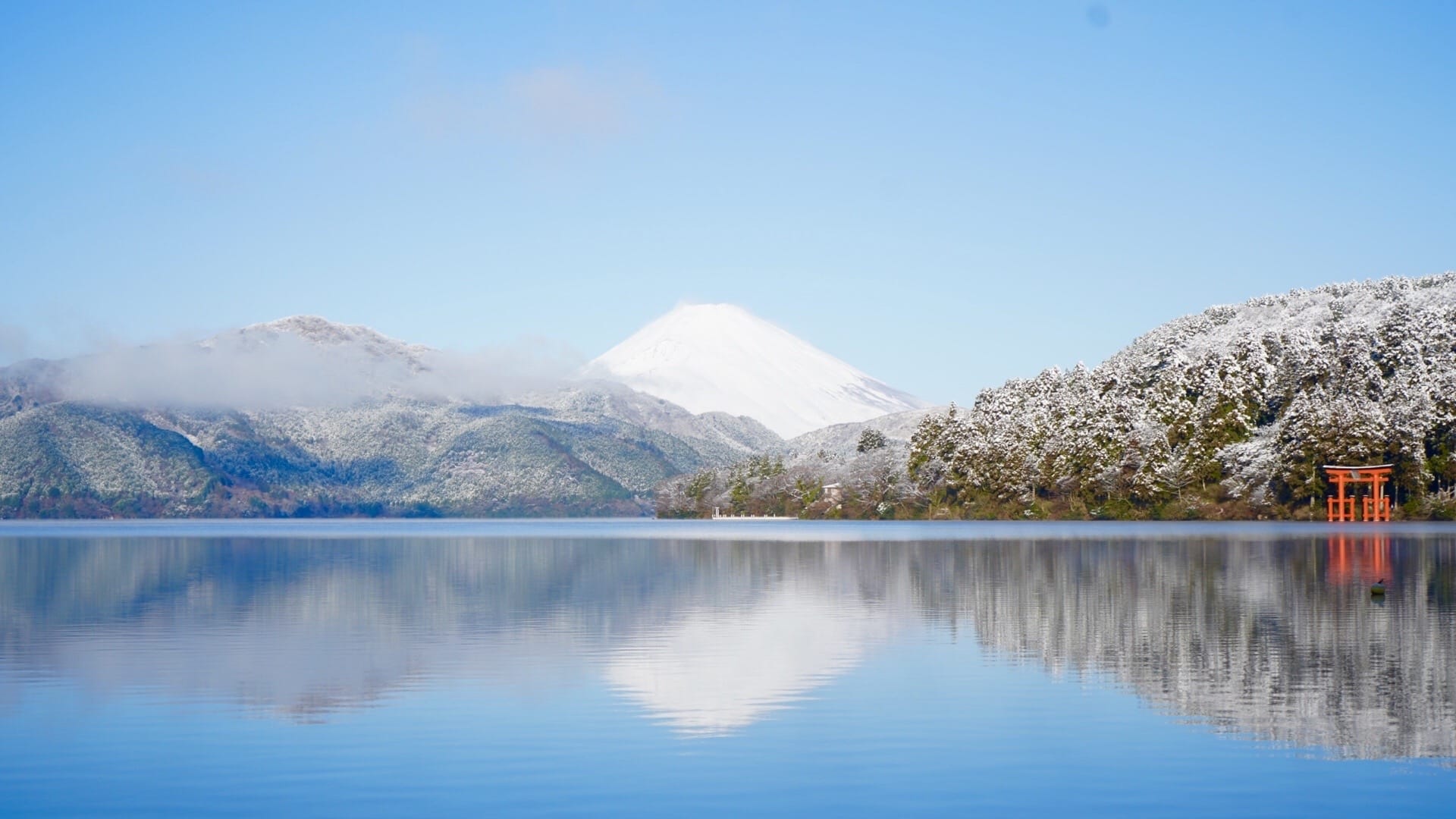Winter in Hakone: Complete Guide to Enjoy Japan's Famous Hot Spring Town
Hakone, one of Japan's premier hot spring destinations, offers beautiful scenery throughout the year, but winter in Hakone has its own special charm.
As you soak in the hot spring bath amidst the crisp, cold air, you'll feel warmth spreading from your core. The spectacular view of snow-capped mountains with Mt. Fuji rising in the background, seen from open-air baths, is a luxury unique to this season.
However, there are some things to keep in mind when traveling to Hakone in winter. Roads may freeze, and heavy snow can disrupt transportation, so it's important to regularly check weather information and ensure proper protection against the cold.
It's somewhat disappointing that daylight hours are shorter, limiting daytime sightseeing. However, this gives you more time to fully enjoy the nighttime scenery and illumination spots.
One of the attractions is its accessibility, being less than 2 hours from central Tokyo. While I recommend visiting as a day trip during your Tokyo tour, staying for at least one night is ideal if you want to leisurely enjoy the hot springs.
Beautiful nature, hot springs, and cuisine. Why not use this article as a reference to spend the ultimate winter vacation in Hakone, refreshing both mind and body?
Throughout Japan, including Hakone, Magical Trip offers guided tours where you can explore local history, traditions, and food culture in depth with local guides.(Hakone Full Day Chartered Private Tour: Art & Nature)
Our most popular tour "Tokyo Bar Hopping Night Tour in Shinjuku" was ranked as Tripadvisor's #1 tour in 2024.

For tourists visiting Tokyo, why not try a private car tour that lets you efficiently visit multiple attractions in a single day? With expert guides who know all the best spots, you can fully experience the region's traditions and rich food culture even in just one day.
These tours include hotel pickup and drop-off service, allowing you to visit attractions stress-free and efficiently. If you're interested in nature-rich destinations like Hakone and want to explore Japan's history and traditions while avoiding crowds, these tours are perfect for you.
・Hakone Full Day Chartered Private Tour: Art & Nature
・Mt. Fuji Full-day Nature Guided Tour with a Private Chartered Car & Guide
Table of Contents
・The Charms of Winter in Hakone
・Access Methods from Tokyo to Hakone
・Recommended Winter Sightseeing Spots in Hakone
・Winter Cuisine in Hakone
・Winter Hot Spring Experience in Hakone
・Frequently Asked Questions About Winter in Hakone
The Charms of Winter in Hakone
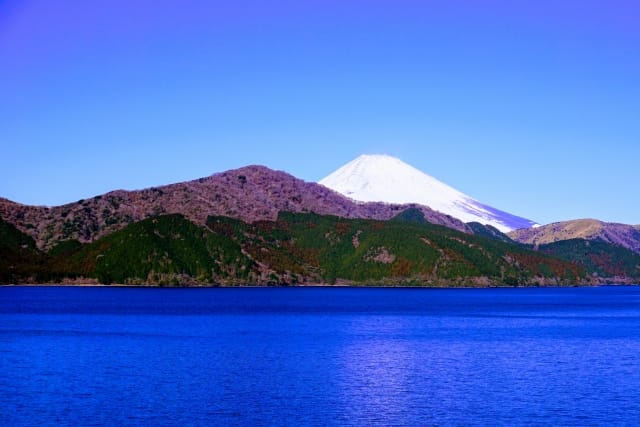
While Hakone is a popular tourist destination year-round, winter, particularly from December to February, is the best time to enjoy the contrast between crisp air, snowy landscapes, and hot springs.
Although temperatures can be severe during this period, averaging around 32°F, with lows of 23°F and highs of around 50°F, this season features high rates of clear skies and offers the most beautiful views of Mt. Fuji throughout the year.
The greatest charm of winter in Hakone is the luxurious experience of viewing snowy landscapes while soaking in hot springs. There are relatively fewer tourists compared to spring and autumn, allowing you to enjoy sightseeing at a leisurely pace.
Also, since the sun sets early, there are spots where you can enjoy illuminations at night.
I have visited Hakone in winter many times, and each time I discover something new. I find it to be a wonderful place that refreshes both mind and body. When I soak in the hot springs amid the clear air and gaze at the majestic Mt. Fuji, I forget the daily hustle and bustle and feel my heart being cleansed by nature's beauty.
I want foreign travelers to experience winter in Hakone at least once. It has unique charms where you can simultaneously enjoy Japan's beautiful nature and hot spring culture. Please make sure to prepare well for the cold and come visit.
Access Methods from Tokyo to Hakone

Getting to Hakone is very convenient by train from Tokyo.
From Shinjuku Station in Tokyo, you can reach Hakone-Yumoto Station in just 85 minutes on the Odakyu Line's Romance Car. Alternatively, you can take the Shinkansen from Shinjuku to Odawara and then transfer to reach Hakone-Yumoto.
I recommend the Hakone Free Pass for transportation. This convenient pass allows unlimited rides on Hakone area transportation for either 2 or 3 days. It can also be easily purchased online, making it convenient to prepare in advance for a smoother trip.
I have used the Hakone Free Pass several times, and I found it extremely convenient for traveling between various parts of Hakone using trains, buses, and ropeways. I think traveling while enjoying the scenery is one of the true pleasures of the journey.
Website: https://www.hakonenavi.jp/international/en/discount_passes/free_pass
Recommended Winter Sightseeing Spots in Hakone
Here are the spots you should visit in Hakone during winter.
Owakudani Ropeway

Owakudani, one of Hakone's popular tourist spots. The ropeway, which offers spectacular views from an elevation of 1,044 meters, is especially recommended in winter's clear air.
Riding the ropeway, you can see the beautiful contrast between the volcanic steam and majestic Mt. Fuji right before your eyes. On clear days, you can see Mt. Fuji in its entirety, with numerous spots perfect for photography.
In winter, the air is clear, offering excellent visibility. You can see far into the distance, allowing even those who have visited before to experience a different charm of Owakudani.
I have visited Owakudani many times, but I feel the winter scenery is exceptionally beautiful. I think the view from the ropeway is a precious experience that lets you appreciate the wonder of Japan's nature.
Website: https://www.hakonenavi.jp/international/en/transportation/hakone-ropeway
Lake Ashi Cruise
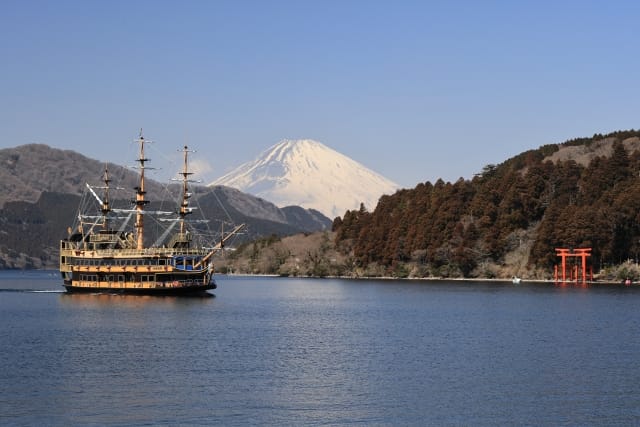
Lake Ashi, Hakone's premier scenic spot. The sightseeing cruise on the lake is a must-visit spot during winter in Hakone.
The view of Mt. Fuji from the pirate ship-styled cruise boat is truly spectacular. On clear days, you can see Mt. Fuji reflected in the lake's surface. I especially recommend the first cruise of the day, when the lake surface is mirror-like and beautiful.
Taking photos from the deck is essential. Capturing the contrast between Mt. Fuji and Lake Ashi in the clear winter air is a privilege unique to this season.
I have taken the Lake Ashi cruise several times, and I discover something new each time. The lake's expression changes dramatically depending on the season and time of day. Winter mornings, in particular, are enveloped in a mystical atmosphere that leaves me speechless with its beauty. I hope you can experience this emotion at least once.
Website: https://www.hakonenavi.jp/hakone-kankosen/
Hakone Glass Forest Museum

Beyond enjoying Hakone's nature, I recommend experiencing its art. Among the art venues, the Hakone Glass Forest Museum is particularly popular.
The museum's centerpiece is a large tree made of crystal glass. During the day, it sparkles in the sunlight, and at night, it's illuminated to create a fantastical atmosphere. During the Christmas season, many candles are arranged, creating an even more romantic space.
I visited during the Christmas season, and the space created by the glass tree and candlelight felt like stepping into a fairy tale. I feel it's a uniquely Hakone experience where art and nature merge.
Website: https://www.hakone-garasunomori.jp/en/
Winter Cuisine in Hakone
Next, I'll introduce the foods you should enjoy in winter Hakone.
Famous Black Eggs

When it comes to Hakone's famous foods, there are the black eggs sold at Owakudani. While they're regular boiled eggs, their shells are black and have a sulfuric smell. This occurs when hot spring minerals adhere to the eggshells.
There's a saying that eating a black egg adds 7 years to your life. While I can't verify if it actually extends your lifespan... please try it as a memorable part of your trip. Since they're boiled in hot spring water, you can enjoy their unique flavor.
I always buy and eat black eggs whenever I visit Owakudani, and I never tire of their taste. The sulfuric aroma that spreads when peeling the shell and the soft texture of the egg are irresistible. When eating warm black eggs in cold winter, I feel warmth spreading throughout my body.
Hakone Soba
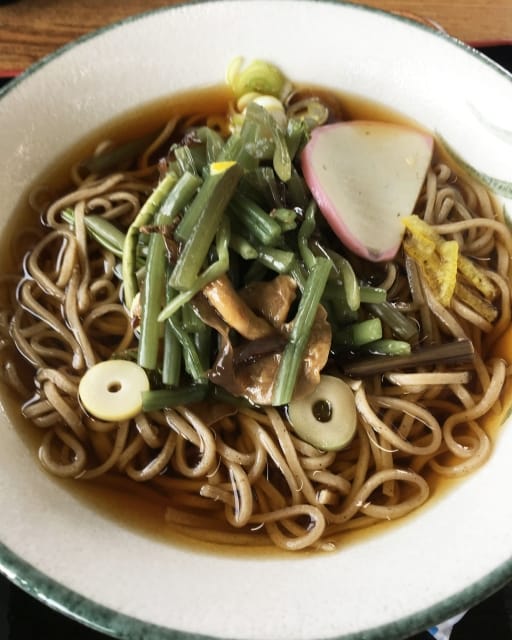
In winter Hakone, I recommend trying hot kakesoba (hot noodle soup). It features a rich broth made with local ingredients.
While Hakone has many long-established soba restaurants that are all reliable choices, the "Mountain Vegetable Soba" is particularly popular. It comes with plenty of mountain vegetables and mushrooms, offering a deep, flavorful bowl.
At my favorite soba restaurant, they cook the noodles promptly after ordering, so you can always enjoy hot soba. I feel it's a Hakone-specific cuisine that warms you up on cold winter days.
Winter Hot Pot Dishes

In cold winter, you crave warm hot pot dishes. Many accommodations in Hakone offer hot pot dishes like sukiyaki and shabu-shabu.
Sukiyaki is a dish where thin slices of beef are simmered in a sweet and savory sauce. It's typically cooked with vegetables, tofu, and shirataki noodles. On the other hand, shabu-shabu is a dish where you briefly cook beef, pork, and vegetables in hot water as you eat. It's enjoyed with ponzu or sesame sauce.
I think hot pot dishes for dinner at accommodations offer a special experience of local flavors. The moments spent sharing a hot pot with family or lovers while soaking in a room's hot spring will surely become precious memories.
Winter Hot Spring Experience in Hakone
While Hakone is famous for hot springs, there are actually two types of hot spring experiences. Here, I'll explain these hot spring experiences.
Day-Trip Hot Spring Facilities
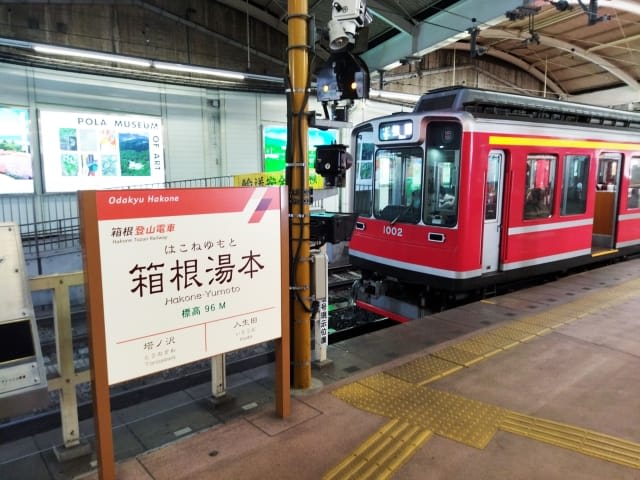
Hakone has long been known as a hot spring town, and many hot spring facilities still exist today. Among them, I recommend day-trip facilities with open-air baths where you can enjoy winter scenery while soaking in hot springs, as they're easily accessible.
Hakone-Yumoto in particular has many day-trip hot springs, and it's fun to explore the hot spring town to find your preferred facility. The snowy scenery viewed from open-air baths will surely heal your daily fatigue.
I make sure to visit a day-trip hot spring whenever I visit Hakone. Soaking in hot springs in the cold winter air helps me relax both mind and body, instantly relieving travel fatigue.
I recommend day-trip hot springs for those who want to make effective use of their travel time.
Ryokan Hot Springs
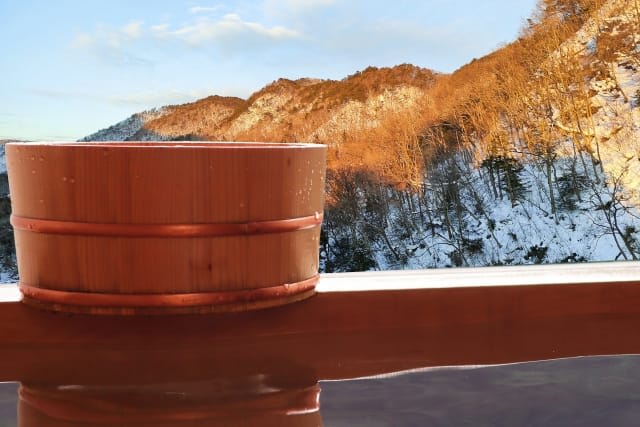
If you want to thoroughly enjoy hot springs in Hakone, I recommend staying at a ryokan (traditional Japanese inn) rather than just a day trip. Luxury ryokans, in particular, offer private hot spring experiences like in-room open-air baths or private reservable open-air baths.
During the cold winter season, rooms with open-air baths where you can enjoy viewing snow while soaking are popular. You can spend luxurious time viewing snowy landscapes from your room.
To fully experience Hakone's charm, I recommend staying at least one night. Enjoy sightseeing during the day and relaxing time with hot springs and room comfort at night. You'll surely be able to fully appreciate Hakone.
I've stayed at luxury ryokans several times, and I still vividly remember the beauty of the snowy landscape viewed from the room's open-air bath.
When watching snow quietly accumulating while hot spring steam rises, I could forget all daily noise and simply become intoxicated by nature's beauty. I think such a luxurious experience is unique to winter trips to Hakone.
Frequently Asked Questions About Winter in Hakone
Finally, I'll answer common questions about the Hakone area based on my experience of visiting many times.
Won't Transportation Stop Due to Snow in Hakone Winter?
While winters in Hakone are cold, unless there's extreme heavy snow, trains and buses generally operate as usual. However, I recommend regularly checking operation information in advance to prepare for sudden weather changes.
Of course, make sure to prepare well for cold weather. Particularly, choose shoes with good grip. Most tourist facilities operate as usual, so I recommend enjoying hot spring hopping especially on snowy days.
I've visited snowy Hakone before, and trains and buses were running as usual, causing no problems for sightseeing. Using public transportation rather than cars or motorcycles allows for safe and convenient movement. If you dress warmly, you should be able to fully enjoy snowy Hakone.
Can I Rent Towels at Day-Trip Hot Springs?
Most day-trip hot spring facilities in Hakone offer towel rental services. Typically, sets include both bath towels and face towels.
This rental service is very helpful for those who don't want to carry towels or want to minimize luggage. While towel quality varies by facility, I find that most provide clean and comfortable towels.
However, rental fees vary by facility, so it's good to check in advance. When I use a new facility, I always check information on their website. Thanks to rental services, I appreciate being able to enjoy hot springs without bringing anything.
This article has thoroughly introduced the charms of winter trips to Hakone. Beautiful scenery and comfortable hot springs that can only be enjoyed in cold seasons. Along with famous local cuisine and art, Hakone is packed with sights to see and experiences to have.
I've visited Hakone numerous times, and I'm always captivated by Hakone's charm as it changes expression with each season. Particularly in winter, I feel the crisp air and snowy scenery, combined with heart-warming hot springs, create the perfect combination.
Make sure to prepare well for cold weather and enjoy winter in Hakone to the fullest. Special moments woven together by spectacular views, hot springs, cuisine, and art await you!
